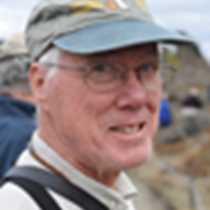Florence Bay and Chatham Strait, Southeast Alaska
Our trip with the islands and wildlife of Southeast Alaska could hardly have begun any better! Last night the National Geographic Sea Bird left Sitka. We passed through Olga, Neva, and then Peril Straits to reach the protected water of Alaska's Inside Passage. Temperate rainforest covered the steep slopes of Chichagof and Baranof islands, on either side of the narrow channel. And the weather; ah, the weather. It is a rainforest, but none of that today. It was clear and sunny as we gathered, balancing a steaming mug of coffee with binoculars and camera for early morning bird watching from the bow, or morning stretches on the aft deck.
On a day such as this, you seize the moment. We entered Florence Bay, a small offshoot of Sitkoh Bay at the southeast corner of Chichagof Island. Our fleet of bright red and yellow kayaks awaited us on the beach, and we could paddle in serenity through the placid water. Bald eagles perched on towering Sitka spruce adjacent to the bay, occasionally leaving their perches to hunt for fish in the productive water. We walked through a magnificent old growth forest of spruce and western hemlock, following a trail used for centuries by coastal brown bears. We remembered that this is their forest; we are but temporary visitors, and we called out occasional greetings to the bears, lest we come upon one unexpectedly.
We left Florence Bay to enter Chatham Strait, the main north-south waterway of Southeast Alaska. We didn't get far! Distinctive tall, pointed fins ... lots of them ... were spotted from the bridge and we found ourselves surrounded by killer whales (aka orca). Killer whales are of two sorts in these waters. Some, called transients, kill and consume marine mammals; others, called residents, are fish-eaters. The two forms do not mix or interbreed; they behave as separate species, and the two forms will soon be recognized as such.
Our whales were of the fish-eating variety. They swim in larger groups than the mammal-eaters, and there were black-and-white living torpedoes all around us. The tall, erect dorsal fins (up to six feet!) drew gasps of awe and a cacophony of camera shutter clicks as the whales passed close by the ship. The photo above shows the distinctive "saddle patch" of a resident killer whale. Details of its form vary from one whale to another. It can be used to identify individual whales and follow their histories, and thus we learn about the population dynamics and social structure of these once reviled but now respected masters of the seas.
We left the killer whales to make our way northward toward our next adventure. We were just beginning to gather in the lounge for evening recap when our plan was interrupted by Dall's porpoise swimming just outside the window. Once more to the foredeck. By hanging over the bow of the National Geographic Sea Bird, we could watch these black-and-white marine mammals taking a ride on the bow wave created by our ship. They are very fast swimming beasts, and it took all the speed we could manage to retain their interest.
Did I say recap? Not tonight. In the distance, we spotted splashing in the water. It was made by a humpback whale lying on its back and repeatedly slapping the water with its long pectoral fins. The whale dove, showing its tail flukes as it descended, but it soon returned to leap from the water, showing us its entire body in a mighty breach before it returned to the water with a huge splash. It did it again and again, as we tried to guess where it would next appear. Just why do the whales choose to engage in this remarkable behavior? If truth be known, we have plenty of hypotheses but few real answers. For whatever reason, it was the perfect climax to our remarkable first day in Southeast Alaska, and on we went to further adventures.




